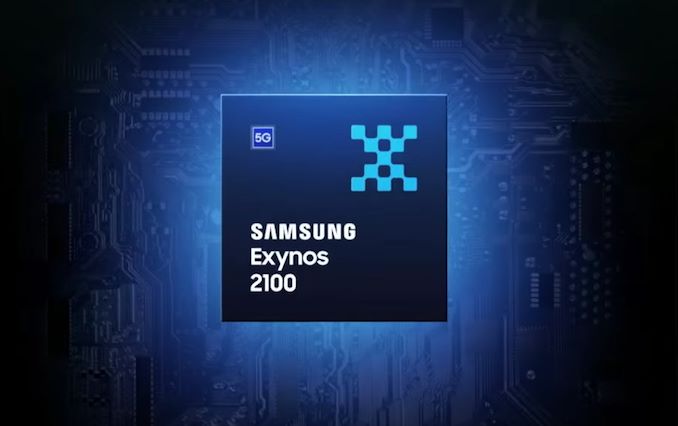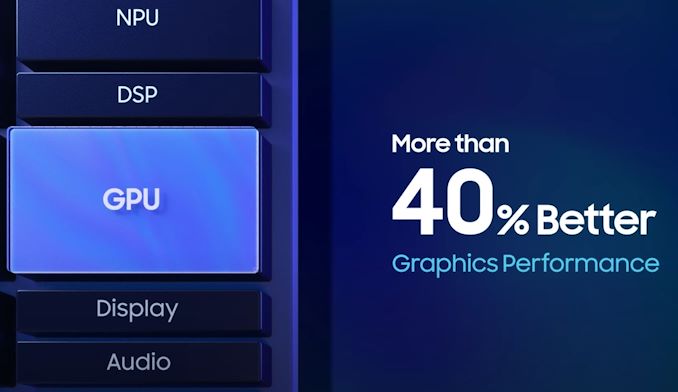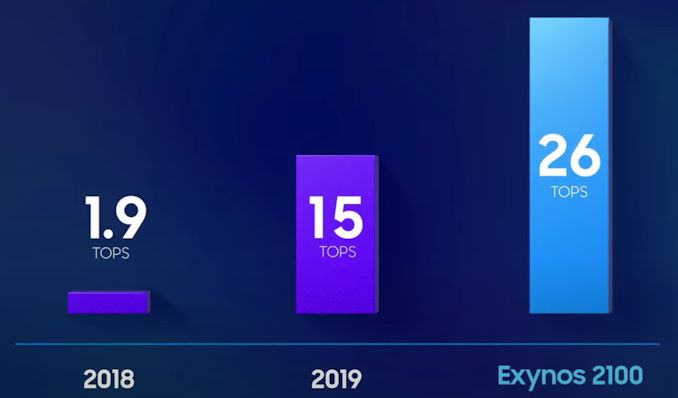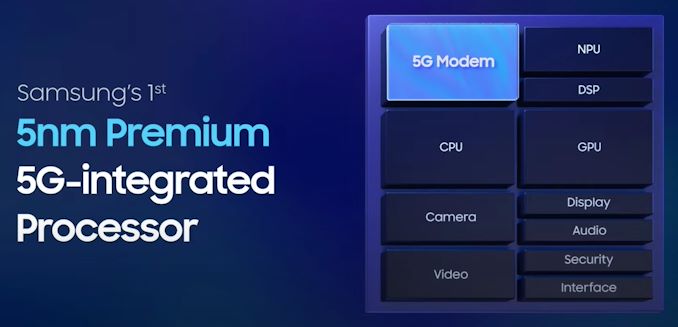Samsung Announces Exynos 2100 SoC: A New Restart on 5nm with X1 Cores
by Andrei Frumusanu on January 12, 2021 10:30 AM EST- Posted in
- Mobile
- Samsung
- Smartphones
- Exynos
- SoCs
- Cortex X1
- Exynos 2100

Today, Samsung LSI took the virtual stage to announce the new Exynos 2100 flagship SoC. The new chip is quite special for Samsung’s chip division as it marks a departure from past iteration designs – being the first SoC not using Samsung’s own in-house performance CPU microarchitecture, but instead relying on Arm’s Cortex cores such as the new X1.
It’s a big change for Samsung not just technologically, but also in terms of general tone and messaging – with a much more upbeat enthusiasm from the company and also the first ever actually presented launch event for a Samsung mobile SoC, more closely mimicking what we would see from Qualcomm.
The new SoC promises some very large technical upgrades – the aforementioned new Cortex-X1 performance CPU, a very large GPU performance boost, but also very large gains in things like AI performance, a re-integrated leading 5G modem, camera support for up to 200MP sensors, AV1 video decoding, all on a new 5nm process node.
| Samsung Exynos SoCs Specifications | |||
| SoC |
Exynos 990 |
Exynos 2100 |
|
| CPU | 2x Exynos M5 @ 2.73GHz 2MB sL2 3MB sL3 + 2x Cortex-A76 @ 2.50GHz 2x 256KB pL2 4x Cortex-A55 @ 2.00GHz 4x 64KB pL2 1MB sL3 |
1x Cortex-X1 @ 2.9GHz 3x Cortex-A78 @ 2.8GHz 4x Cortex A55 @ 2.2GHz ?MB sL3 |
|
| GPU | Mali G77MP11 @ 800 MHz | Mali G78MP14 @ ? MHz | |
| Memory Controller |
LPDDR5 @ 2750MHz 2MB System Cache |
LPDDR5 @ ?MHz ?MB System Cache |
|
| ISP | Single: 108MP Dual: 24.8MP+24.8MP |
Single: 200MP Dual: 32MP+32MP (Up to quad simultaneous camera) |
|
| NPU | Dual NPU + DSP >10 TOPs |
Triple NPU + DSP 26 TOPs |
|
| Media | 8K30 & 4K120 encode & decode H.265/HEVC, H.264, VP9 |
8K30 & 4K120 encode & 8K60 decode H.265/HEVC, H.264, VP9 AV1 Decode |
|
| Modem | Exynos Modem External (LTE Category 24/22) DL = 3000 Mbps 8x20MHz CA, 1024-QAM UL = 422 Mbps ?x20MHz CA, 256-QAM (5G NR Sub-6) DL = 5100 Mbps (5G NR mmWave) DL = 7350 Mbps |
Exynos Modem Integrated (LTE Category 24/18) DL = 3000 Mbps 8x20MHz CA, 1024-QAM UL = 422 Mbps 4x20MHz CA, 256-QAM (5G NR Sub-6) DL = 5100 Mbps UL = 1920Mbps (5G NR mmWave) DL = 7350 Mbps UL = 3670 Mbps |
|
| Mfc. Process | Samsung 7nm LPP |
Samsung 5nm LPE |
|
Starting off with the big-ticket item today, it surrounds Samsung’s usage of the new Arm Cortex-X1 CPU cores. This follows a 5 year journey that had started off with the Exynos 8890 back in 2016 and the Galaxy S7 series of devices- with Samsung using their own designed CPU microarchitecture dubbed the M1 through to the M5 CPU in last year’s Exynos 990 used in the Galaxy S20 series.
Unfortunately, Samsung’s own designs were never really successful, and actually brought the opposite of what the company had hoped for – instead of positive differentiation in the SoC market the usage of custom cores was actually more of a negative, bringing with them reduced performance and quite worse power efficiency compared to the Arm Cortex counterparts. While Samsung had been patient with the SARC CPU design team, too many failures in a row, particularly big blunders such as the Exynos 9810 and the Exynos 990 resulted in the termination of the project, with Samsung now choosing to simply just use Arm Cortex cores.
In last year’s Cortex-X1 announcement from Arm, Samsung was actually one of the leading partners which publicly acknowledged their use of the new high-performance CPU IP, and today’s announcement of the Exynos 2100 unveils the fruits of this collaboration.
The new Exynos 2100 follows a CPU configuration that had been first introduced by Qualcomm in the Snapdragon 855 in that it’s a 1+3+4 CPU design, featuring one new high-performance Cortex-X1 core clocking up to 2.9GHz, three Cortex-A78 cores up to 2.8GHz, and four Cortex-A55 cores at up to 2.2GHz.
What’s interesting here about this setup is the clock frequencies, and how they contrast to Qualcomm’s new Snapdragon 888 which was released a few weeks ago and is starting to ship in the first new flagship devices of 2021.
Particularly on the middle and on the efficiency cores, the Exynos chip shows a 400MHz advantage in clock frequencies over the Snapdragon chip, which should result in a notable advantage when it comes to multi-threaded CPU workloads.
On the part of the X1 cores at 2.9GHz – well it’s a shame we again just missed the mark on the symbolic 3GHz mark this generation, but it’s still 60MHz higher than the Snapdragon counterpart so it should result in a small performance boost, although I doubt it’ll be noticeable.
Samsung actually did have some performance figures shown during the presentation, including the expected 33% multi-threaded performance boost thanks to the now much higher performance middle cores.
I was actually delighted to also see Samsung post a separate 19% single-threaded performance figure – however this number is a bit odd to me as the jump from a 2.7GHz Exynos M5 to a 2.9GHz Cortex-X1 should be larger than that. I don’t know what Samsung uses in terms of coming to these figures, but I’m optimistic that things could end up higher than just 19%.
As part of the launch event presentation Samsung also claimed to have included “better cache memory” – this could be a reference to a possible 8MB L3 cache in the CPU cluster, but could also be related to a better system-cache structure. They had also made mention of a more efficient voltage control implementation – what exactly this means in practice is open to interpretation but one area Samsung could differentiate itself from the Snapdragon 888 is to give the Cortex-X1 cores their own dedicated voltage rail. We’ll have to see how the actual SoC behaves as Samsung doesn’t go into such technical depth for their chip launches.
A 40% GPU Performance Uplift?!
On the GPU side, we’ve seen the move from a Mali-G77MP11 at up to 800MHz to a new Mali-G78MP14 at an undisclosed frequency. That’s generally an expected implementation boost in terms of number of cores – 27% more cores to be exact.
What’s interesting here is the fact that Samsung is proclaiming a massive 40% better graphics performance figure. This actually really gives me pause and I question as to how Samsung has achieved such a figure. The Mali-G78 was meant to be a rather small generational upgrade with only 10% better perf/W improvements. The process node of the Exynos 2100 is advertised as bringing a 20% power efficiency improvement. In theory and on paper, the new process and GPU IP should results in a 32% better perf/W improvement but it’s very rare that such theory-crafting actually results in accurate estimates for actual silicon designs, particularly on the GPU side.
So while 40% performance improvement sounds fantastic, it’ll all depend on how much power and how efficient the new Exynos 2100 is – and how well it can sustain those performance figures in prolonged gaming sessions.
A More Powerful NPU
Another big upgrade is found on the part of the new generation NPU. Samsung has evolved their IP from 2-core design to a new 3-core design, and promises new architectural changes such as pruning and weight compression to improve the power efficiency of the NPU by 2x.
Samsung today proclaimed AI performance figure of 26 TOPS, but this figure seems to be an aggregate figure across all the SoC computational blocks, including CPU, GPU, NPU and DSPs, comparing itself to a 15 TOPS figure of the Exynos 990. The predecessor chipset was actually announced with a 10 TOPS figure last year, so there’s a bit of marketing revisionism going on here, probably wanting to match the figures that Qualcomm is putting out for their SoCs. It’s unfortunate that both companies are resorting to such blurring of the actual IP block performances.
More Powerful ISP - Up to 4 Simultaneous Sensors
In terms of multi-media features, Samsung says to have made large improvements to its camera ISP and DSP’s. The new chip supports single-sensors up to 200MP, while also connecting up to a total of 6 camera sensors, and simultaneously running 4 of them in parallel. At least in this regard, the new chip flexes higher capabilities than the Snapdragon 888 which only supports up to 3 simultaneous cameras. Edit: Qualcomm had reached out to clarify that it supports 5 simultaneous cameras in the form of 3 RGB sensors + 2 monochrome sensors - it's not clear if the Exynos also has such a distinction between it's 4 concurrent sensors.
Samsung has updated its MFC block (Multi-format Codec) video encoder and decoder to support up to 8K60 video decoding, although encoding has remained at 8K30/4K120. What’s interesting here is that Samsung does now support AV1 decoding, marking it the second chipset in the mobile market after MediaTek’s Dimensity 1000 to support the new feature.
5G modem integrated
Finally, the new platform is again a new monolithic design, reintegrating the 5G modem on the same silicon die, promising some gains in power efficiency and allowing for better PCB space usage. The actual modem itself doesn’t seem to have seen notable changes in features compared to the discrete Exynos 5123 modem – however that’s probably because it already was fully featured in terms of supporting all new technologies such as 5G sub-6GHz and mmWave connectivity.
In the announcement video, Samsung made an emphasis that mmWave deployments are growing in 2021, and that we’ll be seeing more Exynos powered devices using mmWave. This is going to be interesting as we haven’t yet seen Samsung’s own mmWave antennas in the market, although the company had let out in 2019 that they had multiple generations of such designs.
5nm Process Node
Finally, Samsung reveals that the new Exynos 2100 is manufactured on Samsung’s 5nm process node, which brings either 10% boost in clock frequencies, or a 20% drop in power at the same frequency. Last year we had suspected that Samsung’s 7nm process node was anywhere between 20 and 25% less power efficient than TSMC’s latest N7P node, so essentially we’re expecting the new process to just catch up in terms of power efficiency, with newer TSMC 5nm SoCs such as the Apple A14 and the Kirin 9000 to still have a notable process node lead.
Positive Messaging, Good Outlook
Today’s launch event was extremely positive in terms of tone and general enthusiasm on the part of Samsung, proclaiming catchphrases such as “Exynos is back” and during the presentation acknowledging that the previous generation SoCs had issues. I think that’s a major change in messaging from the company, and at least on paper the new Exynos 2100 looks to be extremely competitive. I do hope this actual also translates onto the actual products, with the upcoming new Galaxy S21 series in a few weeks’ time sporting the new Exynos chipset for the first time.
Related Reading:
- Samsung Announces Exynos 1080 - 5nm Premium-Range SoC with A78 Cores
- ISCA 2020: Evolution of the Samsung Exynos CPU Microarchitecture
- Samsung Confirms Custom CPU Development Cancellation
- The Samsung Galaxy S20+, S20 Ultra Exynos & Snapdragon Review: Megalomania Devices
- Samsung Announces Exynos 990: 7nm EUV, M5, G77, LPDDR5 Flagship SoC alongside Exynos 5123 5G Modem
















34 Comments
View All Comments
wrkingclass_hero - Tuesday, January 12, 2021 - link
So far Samsung's 5mm seems like a dud... we may have a hot chip on our hands here.Deicidium369 - Tuesday, January 12, 2021 - link
based on what empirical data? - and it's nm not mmyeeeeman - Tuesday, January 12, 2021 - link
Based on the not so empirical data that is Snapdragon 888 that consumes a lot of power, has worse thermals vs SD865+ while performance is not that far off.s.yu - Wednesday, January 13, 2021 - link
They should've called it 6nm to save some face.Eliadbu - Saturday, January 16, 2021 - link
7nm 6nm 5nm, it's all marketing, the name does not tell anything on the node's capability or any other metric. AFAIK TSMC N5 is far ahead in every single metric ahead of samsung 5nm.Makaveli - Tuesday, January 12, 2021 - link
When they released RDNA 2 in this soc but snapdragon version since i'm in NA that is when I will upgrade from my S10.Rudde - Tuesday, January 12, 2021 - link
The Snapdragon version isn't going to have a RDNA based GPU. Or am I understanding you wrong?Makaveli - Tuesday, January 12, 2021 - link
Where did they state the Snapdragon version won't have an RDNA based GPU? now you got me curious.Rudde - Tuesday, January 12, 2021 - link
Snapdragon has used Qualcomm designed Adreno GPUs from the start. Samsung's Exynos meanwhile has used ARM designed Mali GPUs. The partnership between Samsung and AMD is only for the SoCs designed by Samsung, i.e. Exynos. Including RDNA based GPU into Snapdragons would require a partnership with Qualcomm (as the GPU is integrated into the SoC), which would bring the GPUs into competing premium smartphones. Samsung wants a RDNA based GPU to compete with Qualcomm's Adreno, as the GPU is the main differentiation point between Samsung and Qualcomm made SoCs.Makaveli - Tuesday, January 12, 2021 - link
Well then I hope this Exynos version actually equals the same or close performance to the Snapdragon version.